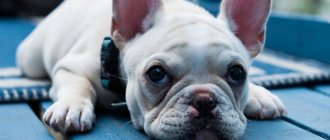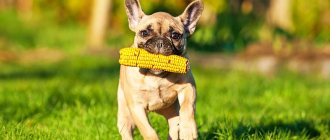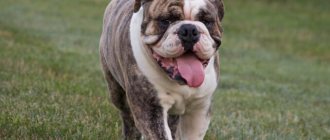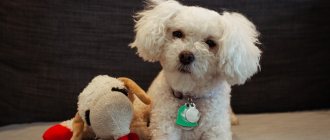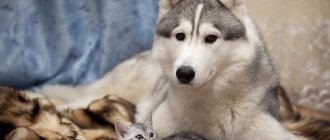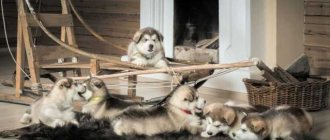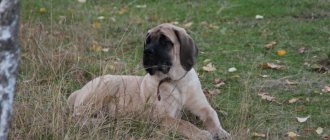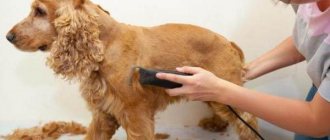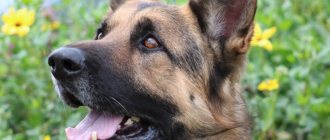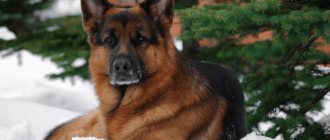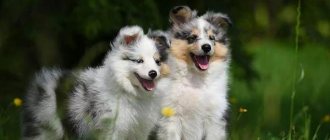Description and features of the Wolfhund
Work on his obtaining a Wolfhund in 1965. The government of Czechoslovakia paid for the experiment. New dogs were sent to work in the country's police and army. Taking into account the supposed specialization of the dogs, they were created on the basis of German shepherds.
48 of the best representatives of the breed were selected for crossing with wolves. There were 4 gray ones. They were named Lady, Brita, Sharik and Argo.
The Wolfhound is also called the Czechoslovakian Wolfdog.
The Wolfhund breed was created by crossing hybrids of the first and second generations. They, like subsequent generations, turned out to be fertile, that is, fertile. This once again confirmed the theory that wolves and dogs have common ancestors and that the species are closely related. Most hybrids are sterile, that is, they are not capable of producing offspring. Suffice it to recall a cross between a donkey and a horse.
The Wolfhounds turned out to be:
- strong and healthy like wolves
- controlled like German Shepherds, but with difficulties in training, which are more difficult for representatives of the breed
- silent, not inclined to speak out often
- outwardly more similar to wolves, having the same slanted eyes with yellow irises, thin and dry lips, a straight bridge of the nose, a rectangular body and a light-colored mask on the muzzle
- erect ears, the landing of which is a little inherited by wolfdogs from shepherd dogs
- with high and muscular paws, on which there are extra toes, removed in early childhood
Recognition of the Wolfhund breed proves the relationship of dogs with wolves
The Wolfhound in the photo comes with a straight or scissor bite. The standard adopted by the FCI in 1993 recognizes both options.
The tail of the wolfdog should be set high. In terms of splendor and length, it resembles a wolf's, often lowered and straight. The tail becomes crescent-shaped and raised in rare moments of excitement of the dog.
The typical color of the wolfdog is yellow-gray. Silver-gray individuals are born less frequently. There are lightened spots on the chest, neck, and muzzle.
What people say
From the words of a person who purchased a Czechoslovakian wolfdog puppy:
Before looking for information about the price and where to purchase, it is worth reading enough information online. This is not quite a dog in the usual sense; the owner is the leader for it. Babysitting and belly scratching will not work here; with such treatment, the dog itself will become the leader and will establish order in its own ways. In addition, without an owner, the wolf dog suffers greatly and tries to follow him everywhere. So you can expect broken windows (if the first floor), torn wallpaper and other delights.
The puppy of this breed is very friendly and enjoys playing with other dogs or even cats. But when he grows up, he begins to treat another animal, to put it mildly, not in the most friendly way. You should not rush and get a wolf dog, because it requires constant training, a firm hand, a lot of attention and movement. The Czech wolfdog is cunning, smart, active, and learns all commands and tricks on the fly. But with poor or improper upbringing, a dog can be dangerous and aggressive to others - the reaction, habits and fangs are still wolf-like. And in case of some incident, this dog will not yap and try to bite, excuse me, on the buttock - the wolf dog will try to overwhelm the enemy.
In conclusion, it is worth saying that the breed is very interesting and unusual. But we should not forget that the ancestors of these dogs were noble and dangerous predators - wolves. So it’s worth taking raising a wolf dog very seriously. And if you succeed, you will raise a loyal friend and partner who will not give offense to the owner even at the cost of his life.
Insurance for a trip to the Czech Republic Get travel insurance without leaving your home! cherehapa.ru The insurance policy will be sent to you by email. All you have to do is print it out. Apply in 7 minutes →
Wolfhund species
The three branches of the breed were not created at the same time. The first was Saarloos's dog. She is not Czech, but Dutch. The selection was carried out by Lander Saarloos, after whom the breed is named. It was recognized by the FCI back in 1981.
The crossing of the she-wolf Flera and the male German shepherd was carried out back in 1925. Actually, the Czechoslovakians acted on the basis of these experiments, creating their own wolfdog in 1955. He turned out to be slightly smaller than Saarloos's dog. The difference in the withers is approximately 5 centimeters. The wolfdog also has a darker color.
Among the dogs of Saarloos there were many whitish ones. However, by 2018, there were only a few purebred representatives of the breed left. The number of Czechoslovakian thistles is stable.
Saarloos Wolfhound
The height of the wolf dog is 65-70 centimeters for males and 60-64 centimeters for females. The weight of the latter is 20-27 kilograms. The weight of males is from 26 to 32 kilos. Litters of 4-6 puppies are typical for representatives of the breed. Their lifespan is on average 12-14 years. The Saarloos Wolfhund lives about the same as the Czech Wolfhund .
Wolfhund became Czech from Czechoslovakian after the collapse of the USSR and the division of Czechoslovakia into two states. Moreover, despite the name of the breed, the FCI gave the rights to it to Slovakia.
The Czech wolfdog, as mentioned, was recognized by the FCI in 1993. But the third type of breed - the Russian Wolfhund remains unrecognized. Otherwise, representatives of the breed are called wolf-dogs. They were brought out already in the 21st century. Selection was carried out in St. Petersburg.
Russian Wolfhund or Wolfhound
Wolves were crossed with Malamutes, large Alaskan sled dogs. Therefore, the Russian version turned out to be tall. Males reach 83 centimeters, and females 79. At the same time, the weight of males is 28-38 kilograms. The weight of females ranges from 23 to 34 kilos.
The size of Russian Wolfhounds is partly due to wolf blood. There are more than 10 species of grays in the world. One of the largest is Canadian. It was he who participated in the breeding.
The color of the Russian Wolfhund is black with a white marking on the chest. On the paws and along the bottom of the body, the fur is also lightened, as if grayish.
Russian wolfdogs live 1-2 years less than Czech ones. This is due to the large size. Large dogs rarely live long lives.
Russian Wolfhound litters are also small in number. There are rarely more than three puppies. The FCI classifies them as hybrids, while the first two types of Wolfhounds are recognized by the organization as dogs.
Czech Wolfdog - shopping time dog
Now it’s worth paying attention to purchasing these wonderful dogs. Nurseries are scattered throughout the world, but not all are worth visiting. In Moscow there are at least 4 nurseries where you can buy a Czechoslovakian wolfdog: Vipdogclab, Vegus, Rare Breeds Club and Best dog clib IKU.
You will find more information on websites dedicated to this breed. You will be provided with the most reliable information about the dogs that you can purchase. Most sites have online consultants who will be happy to help and tell you all the details. As was said at the beginning, the Wolfdog is not one of the cheapest breeds - 1000 euros. Then the price will “jump” depending on the popularity of the nursery.
There is another interesting purchasing option - go for the animal yourself directly to the Czech Republic, choose an authentic specimen. And look at the sights of Prague, and the price will be lower: here we tell you how to do it yourself (after all, you will need a Schengen visa). You can also read about the visa center and the Czech Embassy in Moscow on our website.
Care and maintenance
Like wolves, Wolfhunds exhibit seasonal molting. The thick undercoat, which grows in winter, falls out completely in the summer. Therefore, the Wolfhund is a problematic dog to keep at home.
Molting occurs twice a year, during the off-season. During this time, daily brushing is required.
Heavy shedding is typical for all Wolfhound varieties. Coupled with the large size of the dogs, this speaks in favor of keeping them in enclosures on the street. All Wolfhound species are defined as herding and herding. Representatives of the breed are also used for security service.
Only Czech wolfdogs are good as companions. They are good in the family, in communicating with children. Saarloos dogs and Russian Wolfhunds can be overly aggressive, afraid of loud sounds, not playful, and show especially acute emotions, just like wolves.
The above assumes that most Wolfhounds are cared for as service dogs. Hybrid species have an exceptional sense of smell. That's why:
- In the army, he helps find explosives and illegal border crossers.
- In the police, wolfdogs specialize in drugs.
- The Ministry of Emergency Situations appreciates Wolfhounds for searching for missing people and those in distress.
The service education of Wolfhounds does not imply detachment or keeping the dogs on a chain. Dogs of this breed need socialization. In addition to games and communication, it is important to give pets an understanding of the primacy of the owner. You cannot resort to force in this case. You can conquer a wolf-dog only with the energy of power, but not with physical coercion.
For those who love adventure literature, the Wolfhund will remind you of White Fang from the novel by Jack London. I felt like I had made friends with a real wolf and had his support.
Keeping wolfdogs is made easier by their natural cleanliness and lack of dog odor. Wolfhounds are bathed only 2 times a year. It is important to thoroughly wash the foam from the undercoat.
Once every 1-2 months, wolf dogs have their ears checked. If there is plaque, it is cleaned off with cotton pads or special swabs from pet stores. You also need to clean off tartar. For this purpose, Wolfhounds are taken to veterinary clinics every few months.
Wolf breed
Initially, the purpose of the experiments was to measure the offspring, the level of adaptation, and the indicators of canine and wolf characteristics. But already the second offspring showed good results. Wolfdogs demonstrated excellent immunity in the most difficult climate conditions. It is worth noting that they endured disease and fever both at an early age and in adulthood. The resemblance to a wolf made itself felt only in the third generation. However, wolves differed from both wolves and shepherds. Tests by zoologists have shown a high predisposition to training and learning. These indicators spoke about their suitability for people. When scientists realized that most dogs were not inferior to the new hybrids, they immediately decided that the issue of developing a new breed needed to be taken much more seriously.
The offspring bred back in the 70s and 80s are considered the standard to this day. The dog has a strong, sinewy build, the body has a rectangular regular shape. It looks like a wolf: the color of the mask and the texture of the fur are almost identical. Already from birth, the puppies had strong muscles and well-developed teeth. Instincts are developed at the level of a wolf, so the breed is universal.
Puppies are cute, like all dogs.
If you decide to purchase puppies, you should understand that the Czech Wolfdog requires increased attention and training, because it was bred for work and service, and not for playing at the plate. Of course, this doesn't mean that you won't be able to have fun with her.
The Wolfdog is more trainable than other dog breeds, but its price is not the cheapest - starting from a thousand euros. But this money is completely justified: the wolf dog is faithful to its owner until the last breath. The dog is suspicious of others, but does not attack. As described above, the dog is very active, which means he gets frequent walks in the fresh air. The wolf feels terrible when locked up - this is not a tame miniature toy dog.
The dog's height in adulthood ranges from 60 to 65 centimeters, depending on gender, and its weight ranges from 20 to 26 kilos. The color is quite varied: from silver-gray to yellowish. Dark-colored individuals are also rare. Where the wolf's breed comes through is in the fur. And it’s unusual among wolfdogs, because the fur is noticeably different in winter and summer. For example, during cold winters, the coat forms a thick, dense undercoat with long hair all over the body.
Wolfhund nutrition
In nutrition, wolfhounds prefer the diet of the wolf. The lion's share of the diet should be proteins:
- lean meat
- fish
- dairy
- eggs
- offal
They account for 70% of the wolf dog's diet. Wolfhund puppies eat the same. The remaining third comes from cereals and vegetables in equal shares. Accordingly, 15% is porridge. They should be viscous. It is forbidden to cook oatmeal.
The cereal should swell and soften when doused with kefir or hot water. Fresh meat is also scalded with boiling water. This kills pathogens and helminths, preventing them from infecting the dog. If the meat is frozen, the cold has already done the job. Therefore, it is enough to defrost the product and give it to the dog.
Vegetables can be given to the Wolfhund both fresh and heat-treated. Frying is excluded. It is recommended to boil potatoes, carrots, turnips. It is preferable to give cucumbers fresh.
In addition to basic nutrition, Wolfhounds need mineral and vitamin supplements. There are names specifically for large, service dogs. You can purchase products at pet stores and veterinary pharmacies.
Reproduction and lifespan
Wolf blood made the Wolfhounds' health excellent. With an average life expectancy of 12-14 years, some individuals die only in their 30s. Cases of spontaneous recovery from plague have been recorded. This indicates excellent immunity and the power of the entire organism of wolfops.
Since wolves and dogs interbreed easily, first generation hybrids continue to be produced. Some breeders do this intentionally, while others simply miss the point of mating their dogs with home-kept wolves.
First generation hybrids are unpredictable. About half are as cowardly, aggressive and difficult to train as wolves. The other half of the puppies grow into true dogs, loyal, intelligent. However, in order for a hybrid animal to recognize its owner, it must be adopted at the age of several weeks.
It is not recommended to purchase a pet after a month, like other dogs. It is difficult to recognize the character of a 3-week-old puppy. Therefore, most people try to acquire Wolfhounds in the second and subsequent generations.
Wolfhund puppy
Animals of any generation are easily mated. Problems during childbirth are also rare among Wolfhounds. Puppies are born healthy and strong. Often the entire litter survives.
Breed price
Wolfops cost from 10 thousand rubles. Animals with a pedigree are usually valued at 5 times more expensive.
The price of a Wolfhund depends partly on the species. Saarloos dogs are rare and therefore more expensive. Russian wolfdogs are the most accessible, since they do not have FCI pedigrees and are bred on the territory of the federation. The price tag of Czech Wolfhounds is average.
The relative abundance and prevalence of the breed reduces the cost. However, this was not always the case. Before the collapse of the USSR, Czech wolfdogs were not exported outside the country.
